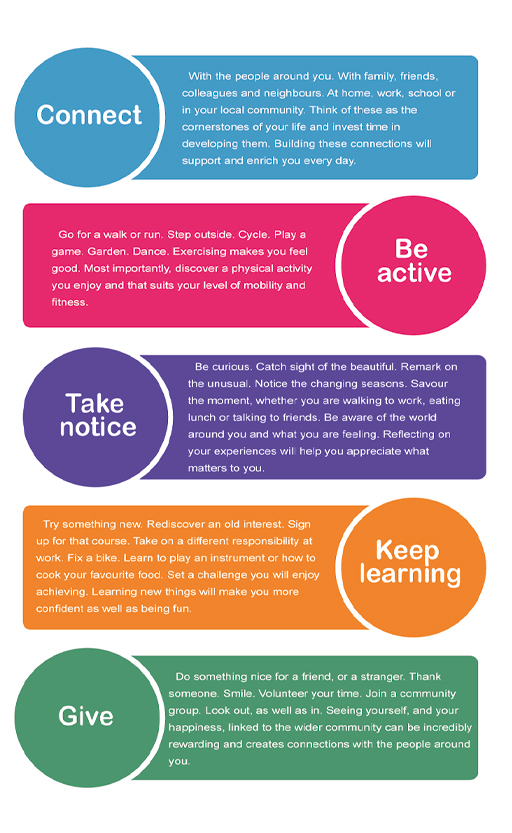1 Why should you be physically active?
The 5 Ways to Wellbeing (Figure 1) are a set of evidence-based public mental health messages aimed at improving the mental health and wellbeing of the whole population. Being active is one of the five messages, with guidance to enjoy physical activity that is suited to individual needs, such as mobility and fitness, given.
When looking across the five messages, it is possible to see how being active can also play a role in the other factors that contribute to wellbeing, such as connecting with those around you. You will notice these crossovers as you work through the session.
But why be active? Lox et al. (2014, p. 9) presents a list of common benefits of physical activity:
- lowers morbidity and mortality rates
- reduces the risk of developing diabetes, hypertension, colon cancer and heart disease
- helps reduce blood pressure in those with hypertension
- reduces feelings of depression, anxiety, and general negative mood
- enhances general positive mood
- improves body images, self-esteem, and self-concept
- helps control weight
- enhances cognitive function
- helps build and maintain healthy bones, muscles and joints
- enhances ability to perform activities of daily living
- provides opportunities to develop social contacts, relationships, and support groups.
Of importance to carers is that many of the listed benefits can address and support the physical and mental health implications of the caring role discussed in Session 1.
Furthermore, evidence suggests that some carers live with multiple long-term conditions and will thus have their own health needs (Public Health England, 2021). Physical activity can be beneficial for those with chronic health conditions, such as cardiovascular and pulmonary disease (Emery, Long & Olson, 2013) and severe mental illness, such as schizophrenia (Faulkner et al., 2013). Indeed, Biddle et al. (2021, p.10) argues that there are few lifestyle choices that can ‘both prevent and help so many ailments’.
This is explored further in Activity 1 where you examine the benefits of gardening as a form of therapeutic physical activity for carers that can be done at home or in the community, such as the Live Well initiative in Barnsley (see Further Reading for more information).
Activity 1
Read ‘The health benefits of gardening’ article (Westcott, 2019) [Tip: hold Ctrl and click a link to open it in a new tab. (Hide tip)] that considers the benefits of gardening for health and for those with existing health conditions. As you read, identify how gardening could be used to reduce some of the physical and mental health implications of caring, which you considered in Session 1, and support carers in their role.
Discussion
You might have been surprised by just how many benefits there are to gardening, both to physical and mental health. According to the article, research suggests that those who garden experience less fatigue and stress, two symptoms commonly found in carers. Furthermore, gardening can boost physical fitness, including building strength. This could support the carer in the physical aspects of their caring role.
In the next section you will explore the benefits of physical activity to both physical and mental health in more detail.

